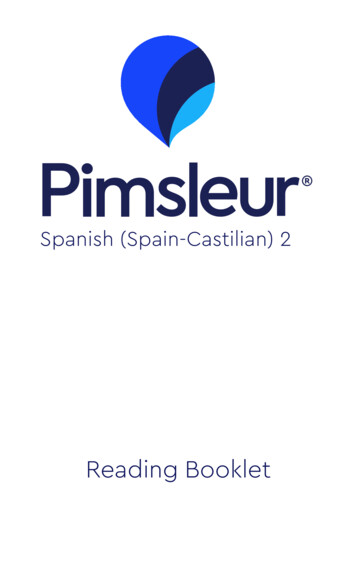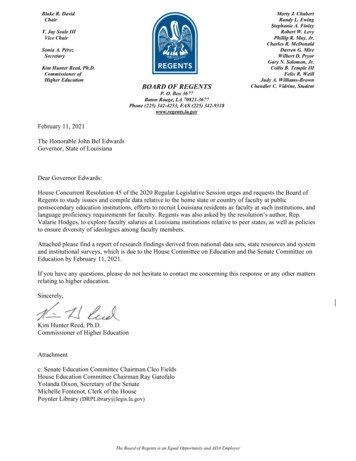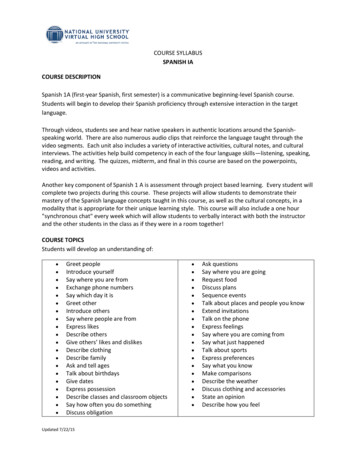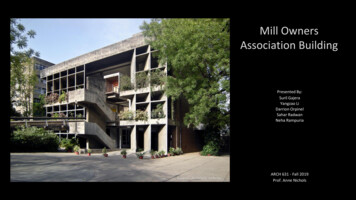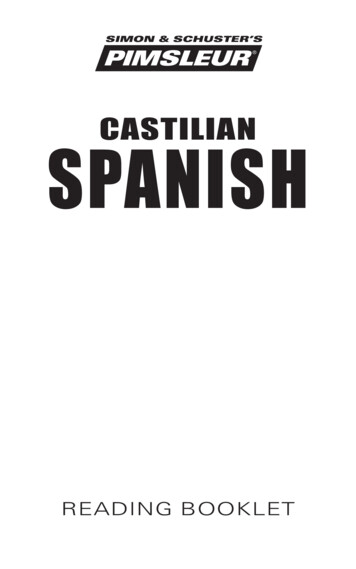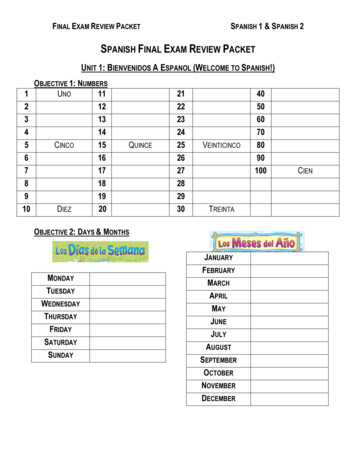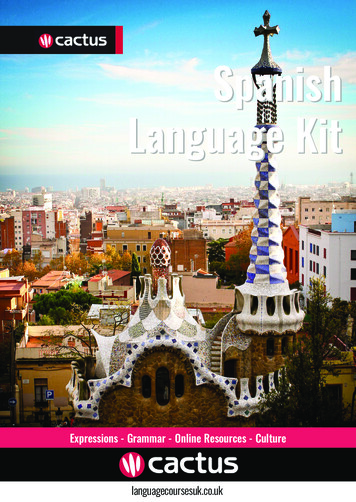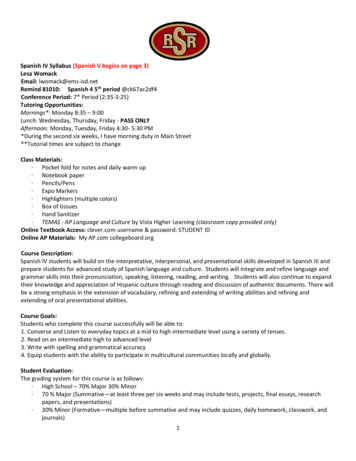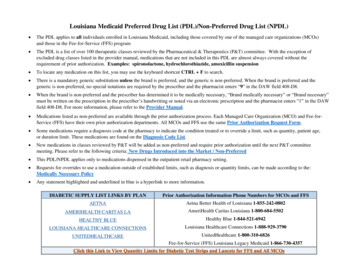
Transcription
2SectionSpanish ControlFigure 19Spanish Colonial GovernmentAs you read, look for:the Spanish plan for the Louisiana colony,the arrival of the Isleños, andvocabulary terms Cabildo and surveyor. King Carlos IIIO’Reilly was also charged with removing French power andFrench law from this now-Spanish colony. He organized thegovernment and the military according to the Spanish colonial policies.Governor of LouisianaOrder and OrganizationO’Reilly used the Spanish colonial law (the law of theIndies) as the model for Louisiana. He replaced the FrenchSuperior Council with the Spanish Cabildo. This group functioned as a town council and as a court of law.O’Reilly selected the members of the first Cabildo. Later,in the accepted Spanish custom, the positions were bought. As time went on,this governing body was given more responsibilities. The New Orleans buildingconstructed for its meetings was also called the Cabildo.O’Reilly intended to stop the British smugglers because this was againstSpanish colonial law. British traders in the Manchac settlement had customersacross the bayou in Louisiana. After France stopped sending goods, thesesmugglers had been the colonists’ only source of needed supplies. O’Reilly setup trade with merchants from the Spanish colony of Cuba. Continuing his work,O’Reilly visited the interior districts of Louisiana to examine the forts. Then heturned to other problems. Because prices for food were too high, he set theprices that merchants could charge. He also made changes in the French slavelaws, abolishing Indian slavery. He improved Indian relations by continuing togive them gifts.O’Reilly then ordered a census to provide the detailed information requiredby Spain. An official surveyor was appointed to measure and mark off boundary lines to establish land ownership. No complete surveys had been done bythe French.Now Louisiana was a true Spanish colony. O’Reilly had been sent by the kingas a military commander to get the colony under control. He had indeed endedthe rebellion and brought order to the colony. In October 1770, Alejandro O’Reillyset sail for Spain. Before he left, he turned the colony over to its new governor.Cabildo Section 2LagniappeThe census commissioned byO’Reilly listed 14,000persons living in Louisiana.About 3,500 lived in NewOrleans. Native Americanswere not counted, andthe majority of the 14,000were slaves.Spanish Control217
Louisiana Under UnzagaBelow: Hovey Cowles (left,as a leather-armouredSpanish soldier) and GusMartinez (right, as anensign) are “interpreters”at Los Adaes SCA. Los Adaeswas a Spanish fort built in1721 to protect Texas fromthe French.218Luis de Unzaga y Amezaga had been sent with O’Reilly to become the governor once the colony was under control. To maintain order, Unzaga needed tohave good relations with the colonists. One of his earliest decisions helped winthem over because it improved their economy and their lifestyles.The illegal trade with the British colony of West Florida continued. The actions of Ulloa and O’Reilly had only increased the smuggling. But Unzaga overlooked the Spanish trade laws and allowed British merchants to set up shop inNew Orleans. This trade and the sound Spanish coin money improved the colonial economy.Unzaga handled other problems with a mild manner and efficient style. Heappointed many French to government positions, making the colonists morewilling to be ruled by Spain. He became even more accepted when he marrieda wealthy French merchant’s daughter. His was among the first of many marriages between Spanish officers and the daughters of the French colonists.The Spanish wanted the colonists to be satisfied with their situation. Otherwise, they might be influenced by the growing tensions in the British colonies. That unrest might explode at any time and spill over into Louisiana.Unzaga strengthened the Louisiana forts by repairing them and bringing inmore soldiers. He also sought the loyalty of Indian tribes by continuing to sellthem firearms. These warriors would be needed as allies if war broke out withGreat Britain.Chapter 7 Louisiana’s Spanish Colonial Era: Stability and Success
The IsleñosThe possibility of war made loyal colonists in Louisiana essential. King CarlosIII, however, still doubted the loyalty of his new French colonists. The Spanishgovernment looked for a group of loyal Spanish subjects. The new colonistscame from the Spanish Canary Islands, which lay off the northwest coast ofAfrica. They called themselves Isleños, the Spanish word for “islanders.”The Isleños came to Louisiana beginning in 1777. They faced disease, hurricanes, lost ships, and delays in the crossing. Many who left the Canaries neverreached New Orleans, but those who did settled throughout the colony.The Isleños had also been brought to Louisiana to join the military. But asoldier’s low pay was not enough to support a family, and the Isleños familieswere directed to become farmers instead. The Spanish government gave themland, houses, cattle, poultry, farm implements, and food to tide them over.Check for UnderstandingAbove: Tommy Benge andBlaine Benge, dressed in thetypical fiesta dress of GranCanaria, receive flowers fromDorothy Benge during the1998 Isleño Festival. TheBenges are descendants ofthe Molero family, who cameto Louisiana from the islandof Tenerife, in the CanaryIslands. 1. Name three plans O’Reilly had for the colony.2. How did Unzaga handle trade?3. Why did Spain send the Isleños to Louisiana?Section 2Spanish Control219
Spotlight New Iberia New Iberia or Neuva Iberia means “new Spain.” In1779, a Spanish official named Colonel FranciscoBouligny founded this town on Bayou Teche. Today,he is honored with a bronze statue in Bouligny Plazain the city.Colonists from Malaga, Spain, were brought to thenew settlement to grow flax. But when they discovered flax would not grow in Louisiana, they raisedAbove: The Conrad Rice Mill in New Iberia is theoldest operating rice mill in America. It was foundedin 1912 and placed on the National Register ofHistoric Places in 1981.220Chapter 7 Louisiana’s Spanish Colonial Era: Stability and Success
cattle and grew corn. Soon these early Spanish settlers merged with the French culture. Spanish namesin Iberia Parish today include Segura, Sanchaz, andMiguez. But these descendants of the Malagans aremore likely to speak Cajun French than Spanish.New Iberia’s most famous house stands on a Spanish land grant on Bayou Teche. This house, known asShadows-on-the-Teche, is a wonderful example of theLouisiana of yesterday. William Weeks gained titleto the land in 1792; his son built the imposing man-sion in 1831. William Weeks Hall (great-grandsonof the original owner) restored the white-pillaredplantation house to its former grandeur. Today, theNational Trust for Historic Preservation guards thisAmerican architectural treasure. The Old Spanish Trail(today’s Highway 90) passes in front of the house.Below: Sunlight filtering through the trees inspiredthe name for the Shadows-on-the-Teche plantationhouse, built in 1831.Section 2Spanish Control221
as a military commander to get the colony under control. He had indeed ended the rebellion and brought order to the colony. In October 1770, Alejandro O'Reilly set sail for Spain. Before he left, he turned the colony over to its new governor. Section2 Figure 19 Spanish Colonial Government King Carlos III Governor of Louisiana Cabildo
